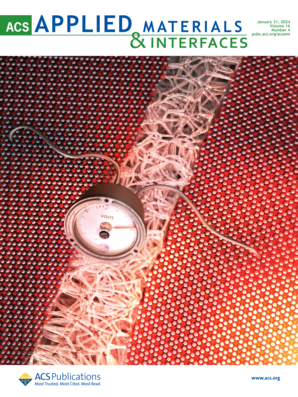玻璃全息光聚合物的多级网络
IF 8.3
2区 材料科学
Q1 MATERIALS SCIENCE, MULTIDISCIPLINARY
引用次数: 0
摘要
在全息光聚合物的书写中,在典型的聚氨酯基体和丙烯酸酯书写单体步骤中添加第三阶段的固化剂来改变最终全息光聚合物的最终热机械性能。热潜伏的低折射率环氧化物均聚物使Tg从写入步骤时的- 22°C增加到环氧化物固化后的最终Tg 101°C。关键的是,衍射光栅结构保持了高保真度,指数对比度为0.0057,衍射效率为89%。最终,这些材料的三阶段设计和最终的玻璃性质促进了最终全息材料的热稳定性和尺寸稳定性。本文章由计算机程序翻译,如有差异,请以英文原文为准。

Multistage Networks for Glassy Holographic Photopolymers
In the writing of holographic photopolymers, the addition of a third-stage cure to the typical polyurethane matrix and acrylate writing monomer steps is used here to modify the ultimate thermomechanical properties of the final holographic photopolymer. Inclusion of a thermally latent, low-refractive-index epoxide homopolymerization increases the Tg from a value of −22 °C during the writing step to a final Tg of 101 °C after the epoxide cure. Critically, the diffraction grating structure is retained with high fidelity, an index contrast of 0.0057, and a diffraction efficiency of 89% achieved in these materials. Ultimately, the 3-stage design and final glassy nature of these materials promote thermal and dimensional stability of the final holographic material.
求助全文
通过发布文献求助,成功后即可免费获取论文全文。
去求助
来源期刊

ACS Applied Materials & Interfaces
工程技术-材料科学:综合
CiteScore
16.00
自引率
6.30%
发文量
4978
审稿时长
1.8 months
期刊介绍:
ACS Applied Materials & Interfaces is a leading interdisciplinary journal that brings together chemists, engineers, physicists, and biologists to explore the development and utilization of newly-discovered materials and interfacial processes for specific applications. Our journal has experienced remarkable growth since its establishment in 2009, both in terms of the number of articles published and the impact of the research showcased. We are proud to foster a truly global community, with the majority of published articles originating from outside the United States, reflecting the rapid growth of applied research worldwide.
 求助内容:
求助内容: 应助结果提醒方式:
应助结果提醒方式:


